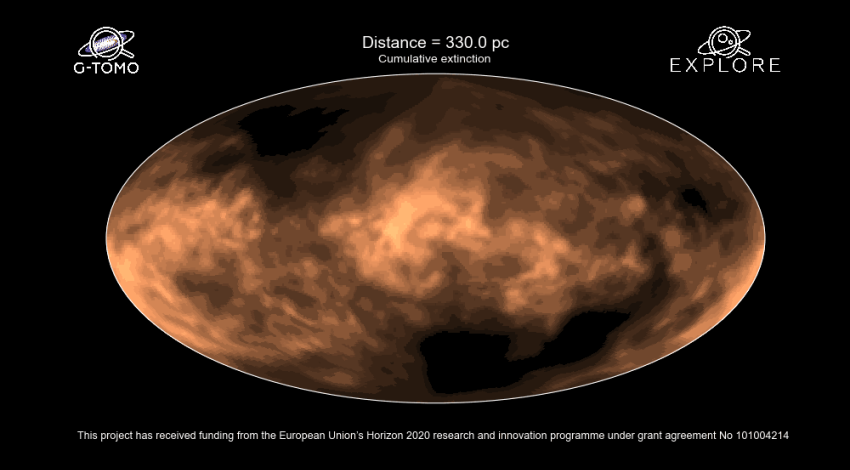An animated dive into the dusty Milky Way exposes the outlines of our galaxy taking shape as we look out further and further from Earth.
 A still from the new animation showing the cumulative build-up of dust looking from Earth’s local neighborhood to around 13,000 lightyears towards the center of the Milky Way. Image Credit: EXPLORE/ACRI-ST/GEPI.
A still from the new animation showing the cumulative build-up of dust looking from Earth’s local neighborhood to around 13,000 lightyears towards the center of the Milky Way. Image Credit: EXPLORE/ACRI-ST/GEPI.
Astronomers have produced an animation to simulate dust in the Milky Way depending on fresh data from an interactive tool that uses information from the European Space Agency’s Gaia mission and other space science data sets. The research was presented this week at the University of Warwick’s National Astronomy Meeting (NAM 2022).
The animation depicts the gradual accumulation of dust as seen from Earth’s neighborhood to approximately ~13000 lightyears away from the galactic center or roughly 10% of the total distance across the Milky Way.
Nearby, dust is all over, but farther away, it is easy to see how concentrated it is along the galactic plane. Additionally, there are two “windows” revealed, one above and one below the galactic plane.
Dust clouds are related to the formation and death of stars, so their distribution tells a story of how structures formed in the galaxy and how the galaxy evolves.
Nick Cox, Coordinator, EXPLORE Project
EXPLORE is developing the required tools.
Nick Cox adds, “The maps are also important for cosmologists in revealing regions where there is no dust and we can have a clear, unobstructed view out of the Milky Way to study the Universe beyond, such as to make Deep Field observations with Hubble or the new James Webb Space Telescope.”
The animation was produced using tools that combined information from the 2MASS All Sky Survey and the Gaia mission. The tools were created with funding from the European Union’s Horizon 2020 Program and are a part of a collection of programs intended to support research on stars and galaxies as well as lunar exploration.
State-of-the-art machine learning and visual analytics have the power to greatly enhance scientific return and discovery for space science missions, but their use is still relatively novel in the field of astronomy.
Albert Zijlstra, University of Manchester
Albert Zijlstra — also associated with the EXPLORE Project — states, “With a constant stream of new data, such as the recent third release of Gaia data in June 2022, we have an increasing wealth of information to mine—beyond the scope of what humans could process in a lifetime.”
We need tools like the ones we are developing for EXPLORE to support scientific discovery, such as by helping us to characterize properties within the data, or to pick out the most interesting or unusual features and structures.
Albert Zijlstra, University of Manchester
Animation of extinction caused by dust looking out from Earth towards the galactic centre
Animation showing the cumulative build-up of dust looking from Earth’s local neighborhood to around 13,000 lightyears towards the center of the Milky Way. Video Credit: EXPLORE/ACRI-ST/GEPI.